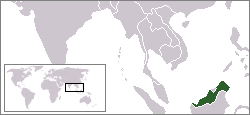East Malaysia
East Malaysia consists of the two states, Sabah and Sarawak, located on the island of Borneo, to the east of Peninsular Malaysia. Together with Peninsular Malaysia, these regions form the country of Malaysia. The South China Sea separates East and Peninsular Malaysia. East Malaysia is known for its dense rainforests, diverse wildlife, and unique indigenous cultures. It is also home to the country's highest peak, Mount Kinabalu, located in Sabah.
Geography[edit | edit source]
East Malaysia occupies the northern and western parts of the island of Borneo, sharing borders with Brunei and Indonesia. The region is characterized by its rugged terrain, extensive rainforests, and a high level of biodiversity. Major rivers include the Rajang River in Sarawak and the Kinabatangan River in Sabah, both of which are vital for transportation and ecology.
History[edit | edit source]
The history of East Malaysia is marked by a rich tapestry of indigenous cultures and a long history of trade and interaction with the outside world. In the 19th century, parts of what is now East Malaysia were under the control of the Brunei Sultanate. The British established the North Borneo Chartered Company in Sabah and made Sarawak a kingdom under the White Rajahs. After World War II, both territories became British Crown Colonies until they joined the Federation of Malaysia in 1963, a move that was met with opposition from Indonesia and led to the Indonesia-Malaysia confrontation.
Politics[edit | edit source]
East Malaysia has a significant degree of administrative autonomy compared to the states in Peninsular Malaysia. Each state has its own government, led by a Chief Minister, and a ceremonial Governor known as the Yang di-Pertua Negeri. The states also have unique immigration policies, requiring Malaysian citizens from other states to carry passports or special passes to enter.
Economy[edit | edit source]
The economy of East Malaysia is diverse, with major contributions from agriculture, forestry, and petroleum. Sabah is renowned for its palm oil and cocoa, while Sarawak is a major exporter of timber and petroleum. In recent years, both states have been working to develop their tourism and manufacturing sectors.
Culture[edit | edit source]
The culture of East Malaysia is markedly different from that of the Peninsular, with a greater emphasis on the indigenous ethnic groups, such as the Iban, Kadazan-Dusun, and Dayak peoples. These groups have rich traditions, languages, and crafts, particularly in beadwork and weaving. The annual Gawai Dayak festival in Sarawak and the Kaamatan festival in Sabah are significant cultural events that celebrate the harvest and indigenous heritage.
Environmental Concerns[edit | edit source]
East Malaysia's vast rainforests are under threat from logging, palm oil plantation expansion, and climate change. Efforts are being made to conserve the unique biodiversity of the region, including the protection of endangered species such as the Bornean orangutan and the pygmy elephant.
Tourism[edit | edit source]
Tourism is a growing sector in East Malaysia, with attractions including Kinabalu Park, the Mulu Caves in Sarawak, and numerous diving spots along the Sabah coast. The region's cultural diversity, wildlife, and natural landscapes draw visitors from around the world.
Search WikiMD
Ad.Tired of being Overweight? Try W8MD's physician weight loss program.
Semaglutide (Ozempic / Wegovy and Tirzepatide (Mounjaro / Zepbound) available.
Advertise on WikiMD
|
WikiMD's Wellness Encyclopedia |
| Let Food Be Thy Medicine Medicine Thy Food - Hippocrates |
Translate this page: - East Asian
中文,
日本,
한국어,
South Asian
हिन्दी,
தமிழ்,
తెలుగు,
Urdu,
ಕನ್ನಡ,
Southeast Asian
Indonesian,
Vietnamese,
Thai,
မြန်မာဘာသာ,
বাংলা
European
español,
Deutsch,
français,
Greek,
português do Brasil,
polski,
română,
русский,
Nederlands,
norsk,
svenska,
suomi,
Italian
Middle Eastern & African
عربى,
Turkish,
Persian,
Hebrew,
Afrikaans,
isiZulu,
Kiswahili,
Other
Bulgarian,
Hungarian,
Czech,
Swedish,
മലയാളം,
मराठी,
ਪੰਜਾਬੀ,
ગુજરાતી,
Portuguese,
Ukrainian
Medical Disclaimer: WikiMD is not a substitute for professional medical advice. The information on WikiMD is provided as an information resource only, may be incorrect, outdated or misleading, and is not to be used or relied on for any diagnostic or treatment purposes. Please consult your health care provider before making any healthcare decisions or for guidance about a specific medical condition. WikiMD expressly disclaims responsibility, and shall have no liability, for any damages, loss, injury, or liability whatsoever suffered as a result of your reliance on the information contained in this site. By visiting this site you agree to the foregoing terms and conditions, which may from time to time be changed or supplemented by WikiMD. If you do not agree to the foregoing terms and conditions, you should not enter or use this site. See full disclaimer.
Credits:Most images are courtesy of Wikimedia commons, and templates, categories Wikipedia, licensed under CC BY SA or similar.
Contributors: Prab R. Tumpati, MD



